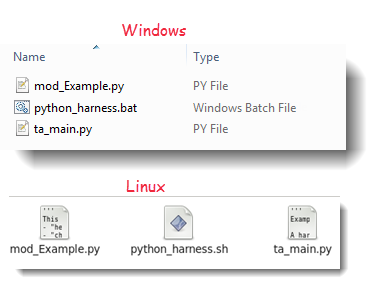Developing your own User-scripted Python harness action
To created a scripted Python action, you must define the action, and modify the existing harness files to implement it.
The folder C:\Program Files\LogiGear\TestArchitect\harness samples\python (Windows), or /usr/local/testarchitect/harness_samples/python (Linux), in the TestArchitect program folder, holds files that act as the entry point for the Python harness. It also has one file, mod\_Example.py, that includes two example user-scripted actions.
The directory looks something like this:
The file python_harness.bat (Windows), python_harness.sh (Linux) is a simple startup script. It first sets the PYTHONPATH variable to the lib/python subfolder in TestArchitect’s program folder; this tells the harness code where to find the Python implementation of the automation library. The files in this folder must be imported by your Python scripts to allow them to access the library’s classes and functions.
ta_main.py is the startup Python script. Running this file executes the main() function, which sets the actions and starts the interpretation.
Your action definitions in Python may be grouped into separate modules, each of which is a .py file; it is in ta_main.py that the appropriate module for a given action is invoked. When a given action definition is requested by the interpreter, ta_main’s DivertToModule() function passes execution to the module in which that definition exists.
At present, only a single module, mod_Example.py, exists in your harness samples/python directory (assuming you have a fresh installation of TestArchitect). It contains the Python code to define two actions:
hello world, which writes the text stringhello worldto the results.check sort order, which checks that the order of rows in a table is ascending, using a specified column for the key values.
The convention is to organize user-scripted functions into multiple script module files, with the name of each such file prefixed with the string"mod_". If you add new actions, you may want to do so in new script files, depending on whether or not the actions logically fit within an existing module.
In this lesson you will write an action and add it tomodule mod_Example.py. In the subsequent lesson, you will write another action, but will create an entirely newscript module to hold it.
As a rule, adding a new action to an existingmodule in the Pythonharness involves these steps:
- Add a line to the list
ofSetActions()function calls, declaring the action for the TestArchitect interpreter. - Add an
else-ifclause to thedivert()function, directing control to a function written to handle the new action. (In the next exercise, you will divert the hello action to aPython function calledaction_hello.) - Create a function definition that provides the actual action-specific logic. (You will write thePython code for
action_hello(), which will do the actual work for the hello action.)
